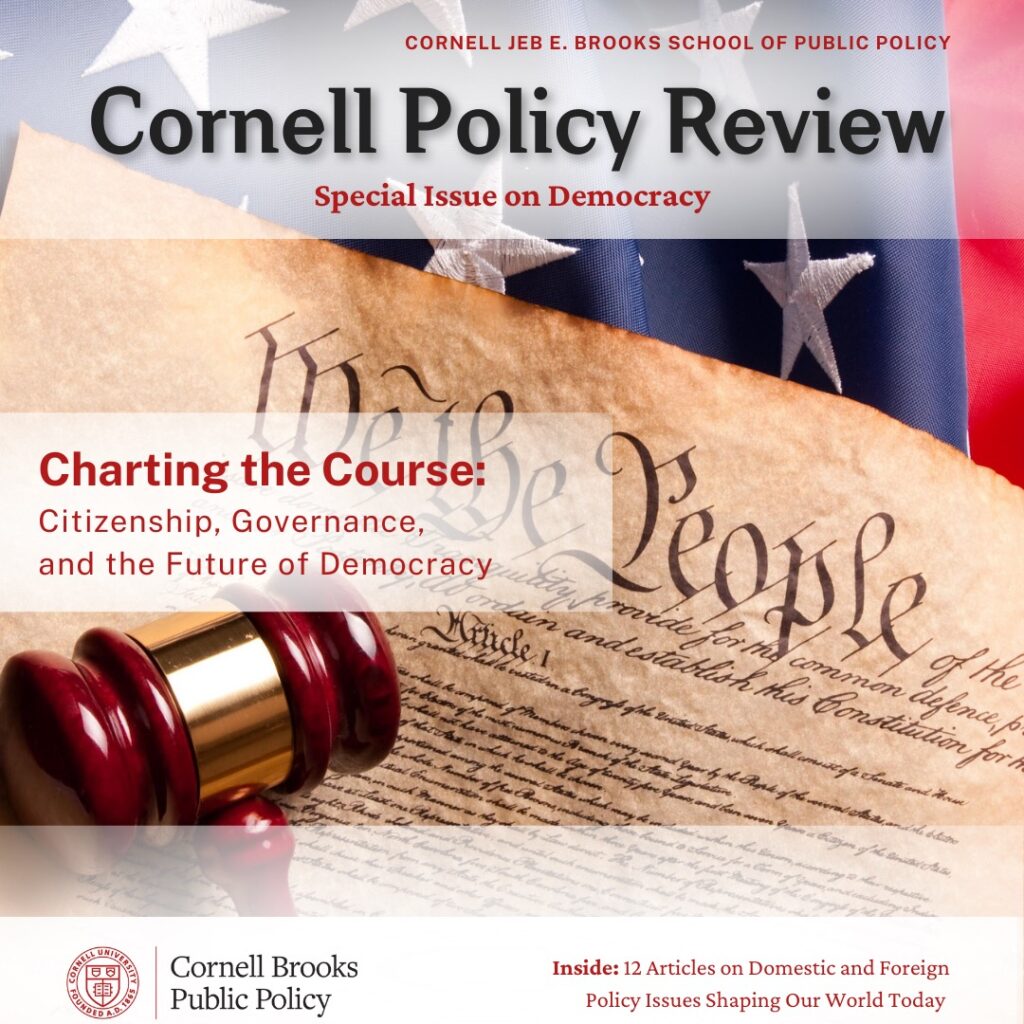By: Emiriana Stanishja and Shipra Mishra
Edited by: Andrew Bongiovanni
Graphic by: Arsh Naseer
Introduction
In 2015, the United Nations adopted gender equality as one of the Sustainable Development Goals as a universal call to action to ensure that by 2030 all people enjoy peace and prosperity.1 With just six years to reach the cutoff date of 2030, the representation of women at decision-making political and bureaucratic levels across the globe still presents an unfortunate picture. Despite comprising approximately 50% of the global population,2 women remain significantly underrepresented in national and international leadership roles. As of April 2024, only 27% of national parliamentarians are women, with only 28 countries having 30 women serving as heads of state or government.3 At this rate, gender parity in the highest positions of power will not be achieved for another 130 years.4 More than two decades into the 21st century, we are still faced with gross underrepresentation of women at almost all levels of decision-making globally. This reflects a serious conundrum about the lack of equal opportunities for women and a gap in gender equality in higher leadership and governance positions. The G20 countries, representing the world’s largest economies, have a critical role in shaping global norms and policies. These nations vary widely in their levels of female legislative representation. Understanding what factors are linked to higher numbers of women in parliament is crucial if we are to make progress towards this aim. This paper seeks to provide a comprehensive analysis of the current state of women’s representation in the G20 national legislatures. By examining the latest data and trends, the study aims to identify the key factors that facilitate or hinder women’s political participation and propose recommendations for enhancing gender equality in legislative bodies.
Literature Review
While studying factors affecting the representation of women in national legislatures, the study by Funk, Morales, and Taylor was found to be insightful and focused on Costa Rica’s Legislative Assembly.5 The study was based on data collected about women’s participation in the committees. The research examines how factors like gender and personal characteristics influence attendance at committee meetings. The study focused on the impact of committee composition and agendas on women’s participation. Although the number of women was found to be lower than the number of men, the study shows the participation of women in community proceedings was equal to men. It was also found that women spoke more frequently during bill deliberations, and they participated more in bill debates.
Pamela Paxton, in their research, has analyzed the determinants of women’s political engagement in the South African Development Community (SADC) region.6 To conduct the analysis, they used data from 14 SADC countries from 2010-2017. The findings show that women’s political participation is positively correlated with labor participation, government functioning, political culture, and political participation. While civil freedom, human development, the election process, and pluralism were negatively correlated with women’s political engagement. The study found that the percentage of women in parliament is significantly greater in the SADC area than in the rest of Africa and the world. The paper about the impact that gender quotas set for women have in national politics by Jennifer Rosen also helped in forming an important variable in this study.7 The dataset used for the purpose of this study included 167 countries during the period from 1992 to 2012 and investigated the impact of gender quota types and other factors in developed and developing countries. Rosen found that voluntary political party quotas have proven to be much more successful in more developed nations. Meanwhile, reserved seat quotas seem to be significant only in least-developed countries. Electoral candidate quotas can be significant in any country, but a quota alone will not achieve the desired aim. The author concludes that there should be penalties for non-compliance with gender quotas, and a minimum mandated threshold of at least 30%.
The study by Forman-Rabinovici and Lilach investigates the effectiveness of gender quotas in increasing women’s political representation within candidate-oriented and programmatically oriented electoral systems.8 The findings show that gender quotas have a more substantial impact in candidate-oriented systems, which typically emphasize individual candidates’ personal qualities over party platforms. This suggests that in systems where women are already at a disadvantage, quotas can significantly enhance female representation by overcoming barriers related to candidate selection and nomination processes. The study underscores the importance of electoral system orientation in shaping the success of gender quotas and achieving gender equality in political representation.
A study by Daniel Stockemer focuses on women’s parliamentary representation in 44 African countries.9 The study explores gender representation in African parliaments, focusing on the impacts of democracy and corruption alongside traditional factors such as electoral systems and quotas. The research reveals that higher containment of corruption is associated with increased women’s parliamentary representation, whereas democratic states paradoxically have fewer female members in parliament than non-democratic states. This suggests that while democracy is expected to support gender equality, its implementation in some African contexts does not always translate into higher female political representation. Additionally, the study highlights the significant role of women’s advocacy in advancing gender equality policies in countries like South Africa, Rwanda, and Uganda, demonstrating the critical link between descriptive representation and substantive policy changes. Another interesting factor to consider while women’s political participation is the cultural factor. An empirical study published by the European Sociology Review about the representation of women in national parliaments uses a large cross-national dataset of a sample of OECD countries to show that the percentage of women’s participation in politics is explained by cultural and regional changes.10
Considering potential factors that may be correlated with women’s participation in legislation, a World Bank report highlights that female labor force participation remains significantly lower than male participation, with global rates just above 50% for women compared to 80% for men.11 A study by Iversen and Rosenbluth argues that women’s underrepresentation in politics is due to both societal attitudes and the structure of electoral systems.12 They highlight that women are at a disadvantage in candidate-centered systems, which prioritize continuous, demanding careers. In contrast, proportional representation systems, which emphasize party labels over individual candidates, offer better opportunities for women. The case of the United States exemplifies this, as women succeed in general-skills jobs but face barriers in politics due to the personalistic nature of its electoral system.
Methodology
This paper used a mixed-method approach, integrating both qualitative and quantitative research methodologies. The qualitative component involves analyzing recent reports and studies to draw findings and conclusions about the state of women’s representation in national legislatures. The quantitative analysis focused on data from the World Bank, United Nations, and OECD, covering G20 countries from 2000 to 2020. The primary dependent variable of this paper is the percentage of seats held by women in national legislatures. While the original research includes regression analysis of various independent variables such as women’s labor force participation, type of parliament, GDP, and tertiary education levels, this paper narrows its focus. The analysis specifically examines the implementation of quota systems in national legislatures, labor force participation, and corruption levels, as well as their association with women’s representation in parliament.
The qualitative analysis provided context and deeper insights into the current trends and effectiveness of gender quotas and the quantitative analysis allowed for a detailed examination of how specific factors interact and influence the presence of women in political roles across different countries. It provided targeted insights into the effectiveness of gender quotas and related socio-economic factors.
Findings
The United Nations Women’s Organization recognizes the importance of equal participation of women in political and public life, evinced by their emphasis of having increase women’s participation as crucial to achieving the Sustainable Development Goals by 2030. However, data show that women are underrepresented at all levels of decision-making worldwide and that achieving gender parity in political life is far off.13 Further, the United Nations Women and the Inter-Parliamentary Union (IPU) have created the “Women in Politics: 2023” map that was referred to for the purpose of this study.14 The data shown in the map highlights the countries with women as heads of states or government, as well as the global share of female ministers. It is reflected in the map that widespread gender inequality persists across countries despite an increase in the representation of women at the highest levels of political power. The data indicate that the advancement of women holding ministerial positions has decelerated, with a modest increase from 21.3 percent in 2020 to 22.8 percent in 2023.15,16 Additionally, in 2023, only 26.5 percent of national parliamentarians are women,17 a slight improvement from 24.9 percent in 2020.18 The UN Women, in their publication, reflect that in 2024, only 27 countries have 28 women serving as the head of state or head of the government. A report by the Congressional Research Service finds that the share of total parliamentary seats around the world held by women was just 15.3%,19 and it can be derived that albeit the progress, it is not a significant increase in terms of total percentage change. As of August 1, 2023, the top seven countries with women holding 50% or more seats include Cuba, Rwanda, Nicaragua, Mexico, Andorra, New Zealand, and the United Arab Emirates.20
When it comes to the G20 countries, Mexico stands out for its high female parliamentary representation, with women holding nearly half of the seats in both the House of Representatives and the Senate. Globally, Mexico ranks fourth in countries with the highest female representation in the parliament, with Rwanda, Cuba, and Nicaragua holding the top three ranks respectively. South Africa and Argentina also have notable female representation in their parliaments, with 46% and 42.4% of seats held by women parliamentarians respectively. On the other hand, India and Japan were the G20 countries with the least representation of women in their respective national legislatures, with just around 14% and 10% respectively.21 While India has had reservations for women in local governance since 1992,22 it was only as recently as September 2023 that the Indian parliament passed a Women’s Reservation Bill to introduce a gender-based quota system reserving 33% seats in the parliament for women.23,24 Globally, sixty-four countries have enacted similar laws to increase women’s representation in national legislatures.25
Based on the regression analyses, the implementation of quota systems displays a strong positive correlation with increased women’s representation. Countries that have adopted any form of quota system, whether it be candidate quotas, reserved seats, or voluntary quotas, show significantly higher percentages of women in their national legislatures. Candidate quotas require political parties to field a minimum number of female candidates. This system has proven effective in increasing women’s representation, particularly in countries where political parties have the autonomy to implement these quotas. For G20 countries that have implemented any kind of national quota system for reservation of seats for women in the parliament, a regression analysis reveals that there was a significant increase in the percentage of women’s representation in the parliament. A 10.27% increase in the representation of women in each country with a quota system in place was observed, holding all other variables constant. This demonstrates the critical role that legislative frameworks play in promoting gender parity in political representation.
The regression analysis also indicated a statistically significant relationship between women’s labor force participation and their representation in national parliaments. Specifically, for every one percent increase in women’s labor force participation, there is an associated increase of approximately 0.991 percent in the proportion of seats held by women in national legislatures, holding GDP per capita and women’s employment constant. This suggests that higher labor force participation among women significantly boosts their political representation. This finding underscores the importance of creating an enabling environment for women to join and remain in the workforce. This can also be backed by the existing research suggesting that policies that support work-life balance, provide childcare facilities, and ensure equal pay contribute to higher labor force participation among women, which, in turn, can enhance their political representation.26
Another factor that emerged as significant during the regression analysis of independent variables was the level of corruption in G20 countries and its association with women’s representation in the national parliament. The level of corruption, as measured by the Corruption Perception Index, was found to have a positive association with women’s representation in national parliaments. In the regression analysis, the variable “corruption” has a positive coefficient of 0.095593, which is statistically significant, indicating lower levels of corruption are associated with higher representation of women in national legislatures. This finding suggests that reducing corruption can create a more level playing field for women in politics, possibly by ensuring fairer electoral processes and reducing the influence of patronage networks that often marginalize women. Several studies on this aspect also support the association between the level of corruption and the representation of women in government. Two substantial studies associate the increased representation of women in government with lower levels of perceived corruption.27,28 More recently, electoral accountability (i.e., voters’ capacity to identify and punish corrupt officials) was also found to play a crucial role in women’s representation.29 The study reveals that increased electoral accountability results in strengthening the relationship between women’s representation and perceived corruption. This analysis supports the argument that corruption levels significantly influence women’s representation in parliament. Promoting women’s participation in politics can be especially effective in democratic settings with high electoral accountability, suggesting that efforts to enhance electoral transparency and accountability could amplify the benefits of increased female representation in reducing corruption.
However, despite progress in policies aimed at bringing gender equality, several challenges remain. Many G20 countries adopt gender equality policies for legitimacy without ensuring substantive changes in women’s political empowerment and participation.30 There is a need to ensure that the increased presence of women in decision-making bodies translates into a genuine representation of their interests and concerns. Simply having more women in these positions is not enough, their participation must lead to tangible improvements in policies and actions that reflect women’s needs and perspectives.
Conclusion
This study emphasizes the persistent underrepresentation of women in political roles, particularly in G20 countries, despite comprising half of the global population. Key factors influencing women’s representation in parliaments include the implementation of quota systems, women’s labor force participation, and corruption levels. Adopting effective quota systems, especially when enforced with penalties for non-compliance, results in higher proportions of female parliamentarians. There is a strong positive correlation between women’s labor force participation and their representation in parliament. Policies that support work-life balance, childcare, and equal pay enhance women’s economic empowerment and political visibility. Lower corruption levels are associated with higher representation of women in national parliaments. Anti-corruption measures create a fairer political environment, enabling women to compete on equal terms. Targeted policy efforts are essential to remove barriers to women’s participation in both the labor force and political life. The implementation and enforcement of gender quotas, along with measures to support women’s labor force participation and reduce corruption, are crucial steps toward achieving gender equality in political representation.
Works Cited
[1] UNDP. n.d. “Sustainable Development Goals.” Accessed May 20, 2024. https://www.undp.org/sustainable-development-goals.
[2] United Nations. n.d. “World Population Day.” Accessed June 17, 2024. https://www.un.org/en/observances/world-population-day.
[3] Inter-Parliamentary Union. n.d. “Global Data on National Parliaments.” Accessed May 20, 2024. https://data.ipu.org/women-averages/?date_month=4&date_year=2024.
[4]UN Women – Headquarters. 2024. “Facts and Figures: Women’s Leadership and Political Participation.” May 17. https://www.unwomen.org/en/what-we-do/leadership-and-political-participation/facts-and-figures.
[5] Funk, K.D., L. Morales, and M.M. Taylor-Robinson. 2017. “The Impact of Committee Composition and Agendas on Women’s Participation: Evidence from a Legislature with near Numerical Equality.” Politics and Gender 13, no. 2: 253–75. https://doi.org/10.1017/S1743923X16000465.
[6] Paxton, Pamela, Melanie M. Hughes, and Matthew A. Painter. 2009. “Growth in Women’s Political Representation: A Longitudinal Exploration of Democracy, Electoral System, and Gender Quotas.” April 27. https://escholarship.org/uc/item/7fw4g5tw.
[7] Rosen, Jennifer. 2017. “Gender Quotas for Women in National Politics: A Comparative Analysis across Development Thresholds.” February 1. Social Science Research 66. https://doi.org/10.1016/j.ssresearch.2017.01.008.
[8] Forman-Rabinovici, Aliza, and Lilach Nir. 2021. “Personalism or Party Platform? Gender Quotas and Women’s Representation under Different Electoral System Orientations.” PLoS One 16, no. 9: e0257665. https://doi.org/10.1371/journal.pone.0257665.
[9] Stockemer, Daniel. 2011. “Women’s Parliamentary Representation in Africa: The Impact of Democracy and Corruption on the Number of Female Deputies in National Parliaments.” Political Studies 59, no. 3: 693-712..
[10] Ruedin, Didier. 2012. “The Representation of Women in National Parliaments: A Cross-National Comparison.” European Sociological Review 28, no. 1: 96–109. https://www.jstor.org/stable/41343472.
[11] World Bank Gender Data Portal. 2022. “Female Labor Force Participation – World Bank Gender Data Portal.” January 10. https://genderdata.worldbank.org/en/data-stories/flfp-data-story.
[12] Iversen, Torben, and Frances Rosenbluth. 2008. “Work and Power: The Connection Between Female Labor Force Participation and Female Political Representation.” Annual Review of Political Science 11: 479-95. https://wcfia.harvard.edu/files/wcfia/files/iversen_workandpower.pdf.
[13] UN Women – Headquarters. n.d. “Women and the Sustainable Development Goals (SDGs).” https://www.unwomen.org/en/news/in-focus/women-and-the-sdgs..
[14] UN Women – Headquarters. 2023. “Women in Politics: 2023.” March. https://www.unwomen.org/en/digital-library/publications/2023/03/women-in-politics-map-2023.
[15] UN Women – Headquarters. 2020. “Women in Politics: 2020.” March. https://www.unwomen.org/sites/default/files/Headquarters/Attachments/Sections/Library/Publications/2020/Women-in-politics-map-2020-en.pdf.
[16] UN Women – Headquarters. 2023. “Women in Politics: 2023.”
[17} Ibid.
[18] UN Women – Headquarters. 2020. “Women in Politics: 2020.”
[19] U.S. Congressional Research Service. 2023. Statistics on Women in National Governments Around the Globe. By Travis A. Ferrel, R45483, November 13. https://sgp.fas.org/crs/misc/R45483.pdf.
[20] UN Women. 2023. “Facts and Figures: Women’s Leadership and Political Participation.” September 18. https://www.unwomen.org/en/what-we-do/leadership-and-political-participation/facts-and-figures#_edn1.
[21] IPU Parline: Global Data on National Parliaments. n.d. “Monthly Ranking of Women in National Parliaments.” Accessed June 10, 2024. https://data.ipu.org/women-ranking/.
[22] Khan, Khadija. 2023. “The 73rd and 74th Amendments, Which First Introduced Reservation for Women in Elected Bodies.” The Indian Express (blog), September 19. https://indianexpress.com/article/explained/explained-law/73-74-amendment-reservation-women-elected-bodies-8947255/.
[23] The Constitution (One Hundred and Sixth) Amendment Act. 2003. The Gazette of India, September 28. https://egazette.gov.in/WriteReadData/2023/249053.pdf.
[24] UN Women – Headquarters. 2023. “India Passes Law to Reserve Seats for Women Legislators.” October 4. https://www.unwomen.org/en/news-stories/feature-story/2023/10/india-passes-law-to-reserve-seats-for-women-legislators.
[25] Ibid.
[26] Hervías Parejo, Vanesa, and Branko Radulović. 2023. “Public Policies on Gender Equality.” In Gender-Competent Legal Education, edited by Dragica Vujadinović, Mareike Fröhlich, and Thomas Giegerich, 405–28. Cham: Springer International Publishing. https://doi.org/10.1007/978-3-031-14360-1_12.
[27] Swamy, Anand, Stephen Knack, Young Lee, and Omar Azfar. 2001. “Gender and Corruption.” Journal of Development Economics 64, no. 1: 25–55. https://econpapers.repec.org/article/eeedeveco/v_3a64_3ay_3a2001_3ai_3a1_3ap_3a25-55.htm.
[28] Dollar, David, Raymond Fisman, and Roberta Gatti. 2001. “Are Women Really the ‘Fairer’ Sex? Corruption and Women in Government.” Journal of Economic Behavior & Organization 46, no. 4: 423–29. https://doi.org/10.1016/S0167-2681(01)00169-X.
[29] Esarey, Justin, and Leslie A. Schwindt-Bayer. 2018. “Women’s Representation, Accountability and Corruption in Democracies.” British Journal of Political Science 48, no. 3: 659–90. https://doi.org/10.1017/S0007123416000478.
[30] Kalemci, Arzu, Ela Canbolat, and Ipek Tuzun. 2024. “Effectiveness of Gender Equality Policies in G20 Parliaments: A Fuzzy Logic Analysis.” In International Conference on Gender Research. https://doi.org/10.34190/icgr.7.1.1996.
Author Bios
 Emiriana Stanishja ’24, MPA alumna at Cornell Brooks School of Public Policy. | Significant experience with the Public Debt Department of the Ministry of Finance and Economy in Albania. She has a strong interest in economic and financial policy, specifically in public debt management, fiscal policy analysis, and financial risk assessment. Currently, she works as a Consultant for the Debt Data Team at the World Bank.
Emiriana Stanishja ’24, MPA alumna at Cornell Brooks School of Public Policy. | Significant experience with the Public Debt Department of the Ministry of Finance and Economy in Albania. She has a strong interest in economic and financial policy, specifically in public debt management, fiscal policy analysis, and financial risk assessment. Currently, she works as a Consultant for the Debt Data Team at the World Bank.
Shipra Mishra ’24 is a public policy professional with an MPA from Cornell University, and an undergraduate degree in law. She has extensive experience in the energy sector, having worked on policy research and legislative reforms for the Federal Minister for Coal & Mines in the Government of India. At Cornell’s Climate Jobs Institute, she focused on policy analysis at the intersection of renewable energy policy and labor equity. Her interests include working at the intersection of law and public policy, energy policy, and global development, focusing on South Asia.



